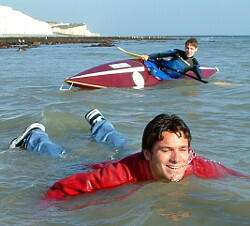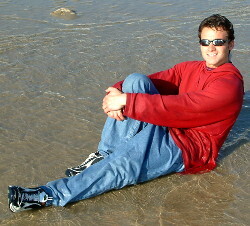Beach Workout
Swimming and running combine into a good cross-training exercise for lifeguards as it is a similar challenge to a beach rescue.
Practice at Meal Time
The best way is to practice some of the exercises below is with every meal. This may sound like a terrible idea for some people, but it is actually incredibly efficient. Lifeguards should stick to the mealtime schedule. Do them before every meal. Some people would prefer to do them after.
It is just important that they are done at every meal time. Nobody is going to the gym three times a day to work the abdominals. Our training gives you a distinct advantage for real exercises in the sea or pool.
Bodyweight Exercises
These exercises use your own bodyweight as resistance,
geared for all people, no matter what their fitness level may be.
They are literally the only workouts you need to get in shape.
The push-up, pull-up, sit-up, crunch, squat, jump squat, and dip exercises are the most common examples.
They all require virtually no equipment to perform, just some clothes that add weight when wet.
Training Overview Menu
If you find the workout below too tough, halve the numbers. Too soft? Double the numbers.
- 300 Meter Warm-up Run
- 300 Meter Swim using breast and/or sidestroke
- Run 1 km in under 10 minutes
- 30 Surf Push-ups in 2 minutes
- Flutter Kicks in the surf for 2 minutes
- Water Squats for 2 minutes
- 300 Meter Swim using breast and/or sidestroke
- 30 Surf Sit-ups in 2 minutes
- Cool Down and have fun afterwards
Warm-up Run
The warm-up run should start slow and then gather pace. While you're still mostly dry, run along in the shallow water. Loosen up, splash about.
Try to kick up some water with each step by pushing your foot forward a bit as you put it down. If you do it right, you throw up a big bow wave of spray before you.
Over time run in slightly deeper water. The increased resistance builds up your leg muscles and lower core strength. Finish off with a dip in the sea. Back to Menu


300 Meter Swim
Now the real fun training starts. Wade into about chest deep water and swim 300 meters along the shore at a steady pace.
Maximum time allowed is 12 minutes. To be competitive, you should swim the distance in at least 8 to 9 minutes, using only the Combat Swimmer Stroke, sidestroke, or breast stroke.
Pace yourself. Try 5 to 10 sets of 50 meter swims, working on a pace that will get you below the competitive times.
Rest 5 minutes after swimming before moving on to the next exercise. Back to Menu
Run 1 Kilometer
Run in shallow water for 1 kilometer wearing your waterlogged clothes. The maximum time allowed for this run is 10 minutes, but you should be able to cover the distance in 8 to 9 minutes to be competitive.
Pace yourself. Do not start off too fast on the first lap. Shoot for a moderate run time around a standard high school track.
Repeat this pace for six to 10 sets until you no longer have to rest in between sets.
As before in the warm up run, you may want to run in slightly deeper water to further build up your leg muscles.
Finish off with a refreshing dip under the waves and relax for a minute or two before you do the next exercise, to reduce the lactic acid build-up in your muscles. Back to Menu
Surf Push-ups
Getting soaked at boot camp is a lot less scary for people who can already do a bunch of surf push-ups really well.
Your push-ups should also be varied. Wide-arm, narrow-arm and incline push-ups are all great ways to get the most out of each work out. It may be necessary to focus on a different type of push-up for each mealtime workout.
Women should begin doing push-ups on their knees. By the end of the month, they will be ready to face lifeguard aquatic boot camp.
Measure your progress each week. People that dedicate themselves to one month of preparation will surely have the easiest time at aquatic boot camp.
Get Started
Kneel down on the edge of the surf where waves can still reach you and place your hands flat on the beach, slightly wider than shoulder width apart. You can either point your head or your feet towards the waves. With your shoulders directly over your hands, straighten your arms.
Move your feet back placing your toes on the beach. At this point, your body should form a straight line from your shoulders to your ankles.
Your body should remain straight throughout this exercise. Keep your head and neck in line with your body so that your are looking down.
This is the starting position. In a controlled fashion, lower your body down into the water, bending your elbows, until your body is nearly touching the beach.
Now, push your body up away from the floor, straightening your arms, until you have returned to the starting position.
Perform a minimum of 30 surf push-ups in 2 minutes. Let the waves wash over you and push you around. Keep your orientation. Put on more clothes as you get stronger.
Target
Minimum number is 40 in 2 minutes, but you should shoot for at least 100 for an average score. Do not pace yourself. Push as many push-ups out as fast as you can, but do not neglect proper form or they don't count. Back to Menu
Flutter Kick
The flutter kick is often used as an intensive training tool in the military to develop the hip flexors, abdominal muscles, and leg muscles.
After a good run it is time to lay back in the surf. Legs must be locked, with toes pointing away from the body.
Start by lying flat on your back in shallow water with the feet and head approximately 15 cm (6 inches) off the ground. Hands are under your buttocks to support your lower back.
- Raise the left leg to a 45-degree angle, keeping the right leg stationary.
- Raise the right leg off the ground to a 45-degree angle while, at the same time, moving the left leg to the starting position.
Repeat for 2 minutes. Increase the speed. Then move on to the next exercise. Back to Menu
Water Squats
Let's do some Water Squats. Start with 20.
"Squats? What’s that?" you ask.
Easy. Wade into hip deep water. Plant your feet about shoulder-width apart, and a little angled away from each other. Now bend your knees and squat down until you're neck deep in the water. Then come back up. That's one squat.
"This is too easy." you say.
Yes, it's easy. Just wait until you do 20. Your heavy waterlogged clothes will make this a serious challenge over time. Then there are the waves trying to push you over. Good fun.
If you really want to fire up your engine, do jump squats instead of normal squats. It is exactly as it sounds. As you come up from your squat, jump straight up with full force. This can be quite tough with all your kit on, but keep at it. These jumps really help train your legs to a higher level.
Another great exercise is the single leg squat. Put one leg behind you and squat down as far as you can go, a 4 second eccentric movement is ideal for building muscle, burning fat and of course increasing your leg strength. Come up and repeat with the other leg.
For the side twist swing your hands in the water from side to side while standing. Repeat when down in the water. Turn at the waist wit the move. This stretches your back muscles.
Other great exercises include Star Jumps, Squat Thrusts, or a complex mix such as a push up, squat thrust, where you jump as high as you can. This is extremely good for burning fat and activating muscle fibres.
We're big fans of this exercise and find it a great one to add into your routine.
Back to Menu
Final 300 Meter Swim
As before, wade into about chest deep water and swim 300 meters along the shore at a steady pace.
Some teams swim out to a set of buoys, escorted by lifeguards in boats. In our example, you would swim out 100m, between two buoys for a 100m, and back in for 100m.
If you don't have lifeguards in boats,
it is safer to swim just behind the surf line within easy reach of your lifeguard on the beach.
Back to Menu
Surf Sit-ups or Curl-ups
It is worth remembering that your abdominal muscles will be trained to help stablise your body for certain movements such as standing biceps curls. For this reason, it is best to perform any abdominal exercises at the end of your workout routine.
Sit ups are probably the most often performed abdominal exercise. They are appropriate for all levels to help develop your abs, but they must be done correctly.
The simple key to improve abdominal strength is the speed with which you perform the movement. If you work too fast than you are not working your abdominal muscles, you are simply increasing the risk of injury to your lower back. Work slow and they will grow!
The purpose of doing curl-ups and sit-ups is to strengthen the abdominal muscles, particularly the rectus abdominis.
Having strong abdominal muscles helps you maintain good posture, with your back and pelvis properly aligned.
This makes your movements more efficient and can keep your lower back healthy and pain-free.
While sit-ups used to be the norm in physical fitness assessments and workouts,
curl-ups have become increasingly more prevalent
due to their effectiveness for strengthening the abdominal muscles and their reduced potential for injury.
Begin sitting down in a place where the waves can reach you, feet on the floor, knees bent.
The waves will try to push you off balance.
Learn to handle that.
Place your fingers to the side of your head, elbows out to the side. Your hands will only support the weight of your head, not pull you up.
Look straight ahead, keeping your chin up off your chest. This will help to keep your neck in a relaxed, neutral position.
Inhale and lay back into the water. Slowly lift your shoulders, neck and head. Your elbows should stay out to the side, your neck relaxed.
With your abs contracted, lift until you are sitting upright, hold for a second, then exhale and slowly return to the starting position in the water. Pause once more, then repeat.
The key to this exercise is smooth, slow movements, feeling the contraction in your abs the whole time.
Beginners should aim for two sets of 8 - 12 reps.
Intermediates two sets of 15 - 20 reps.
Advanced should do three sets of 20+ reps.
Rest for 20 seconds between sets.
Target
Minimum number is 50 in 2 minutes, but you should strive for at least 100 in 2 minutes for an average score.
Pace yourself!
Aim for 20 to 30 sit-ups in 30 seconds; that will put you within the 80 to 100 sit-ups range for 2 minutes.
Back to Menu
Cool Down
Afterwards splash around with your friends and enjoy the water. Hop around or throw each other in the air. Whatever makes you happy and helps you to relax.
A nice, slow jog or swim gives you an opportunity to savour the achievement of completing a workout, and a chance to swap laughs with your training partners once the hard work is done.
Repeat the whole sequence as often as you can.
Back to Menu